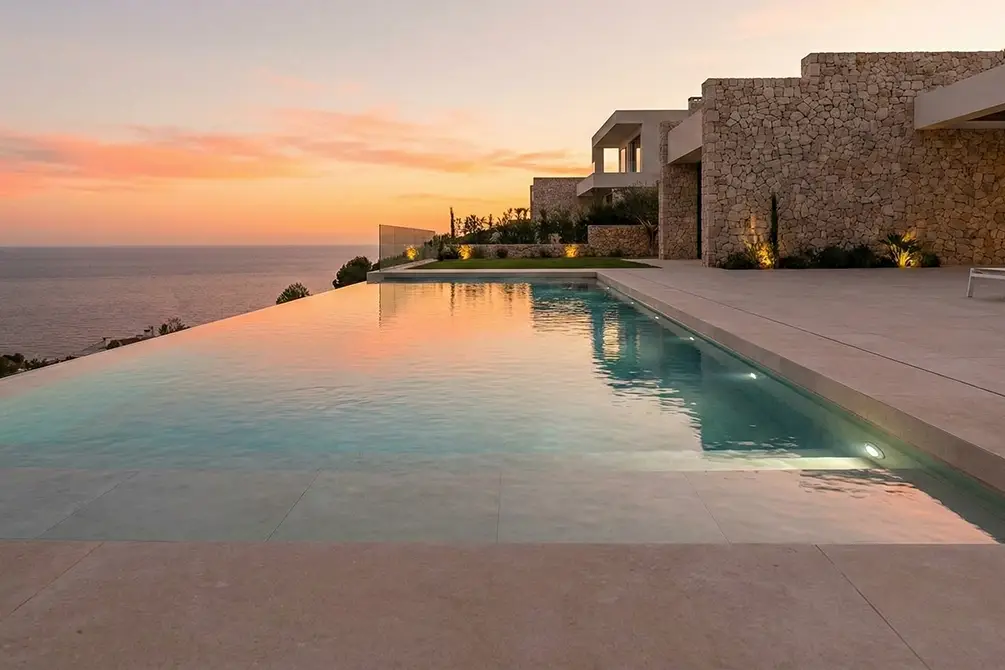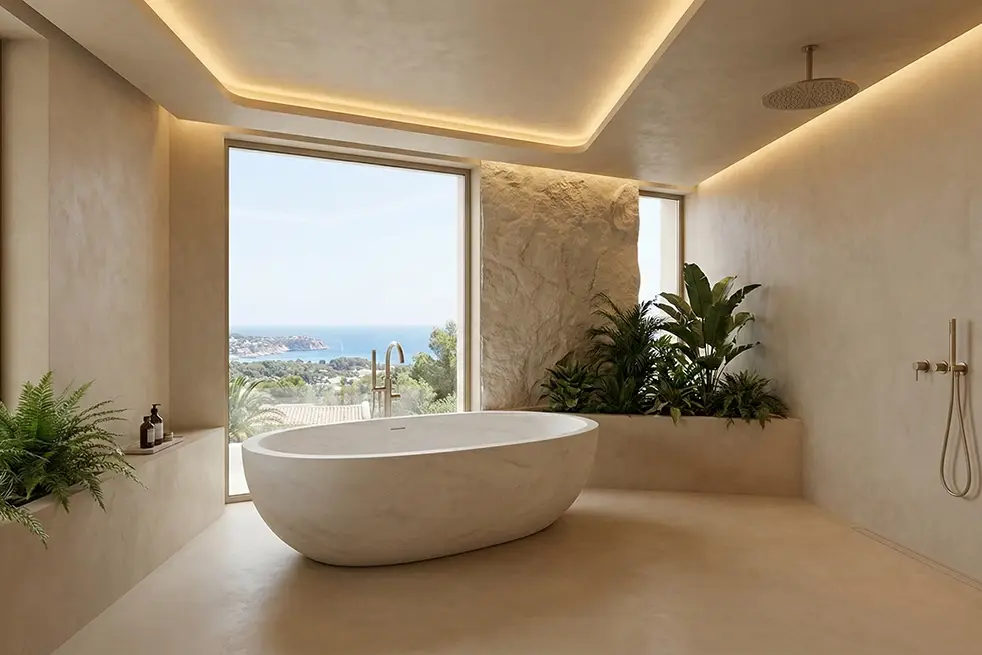Modern mediterranean house designs
Mediterranean architecture has a special magnetism. Its warmth, simplicity, and connection to the coastal landscape have made it one of the most desirable aesthetics in home design. However, when blended with contemporary design elements, it achieves a magical formula that is as functional as it is beautiful. Modern Mediterranean houses invite you to live with all five senses—especially when built in privileged locations like the Costa Blanca.
This area of the Alicante coastline, blessed with more than 300 sunny days per year, clear skies, and a millennia-old cultural heritage, provides the ideal context for the Mediterranean style to flourish with renewed strength. It’s no coincidence that renowned national and international architects are reinterpreting this traditional language, incorporating clean lines, sustainable materials, and bioclimatic solutions.
In this article, we’ll guide you through key concepts, examples, and tips to help you plan your dream home, blending identity, modernity, and harmony with the surroundings. Whether you’re looking to build from scratch, renovate an older home, or simply find inspiration, you’ll find valuable insights here.
Why choose the Costa Blanca for your mediterranean home?
Climate as an architectural advantage
One of the greatest assets of the Costa Blanca is its mild climate, characterised by gentle winters and warm summers. This not only improves quality of life but also enables the use of passive design solutions such as shaded porches, ventilated inner courtyards, strategic solar orientation, and thermal materials like stone or terracotta. In other words: design that enhances comfort and energy efficiency.
The influence of coastal living
Living by the sea transforms how we use our homes. Here, outdoor spaces such as terraces, pergolas, or solariums are not mere accessories, but rather extensions of the living space. The modern Mediterranean house fully embraces this dynamic, offering hybrid spaces where indoors and outdoors blend seamlessly.
Mediterranean aesthetics with a modern twist
Colours, materials, and textures
White remains the reigning colour, but it’s no longer the only one. Modern Mediterranean houses incorporate sandy hues, soft ochres, light woods, and local stone. Regarding materials, emphasis is placed on noble yet low-maintenance finishes, such as lime mortars, exposed concrete, handcrafted ceramics, or treated wooden slats.
Minimalism and functionality with soul
Though modern design typically leans towards simplicity, in Mediterranean homes the goal isn’t to remove character, but to refine it. Pure volumes, horizontal lines, high ceilings, and open-flow layouts that facilitate effective natural ventilation are prioritised.
Landscape integration in aArchitecture
Gardens with native species
Planting species that thrive in dry climates, such as lavender, rosemary, olive trees, or oleanders, not only beautifies the surroundings but also reduces water consumption and garden maintenance.
Designing terraces with sea views
A good Mediterranean terrace acts as a viewpoint: floating balconies, open porches, and chill-out zones shaded by wooden or reed pergolas provide both shade and direct visual connection to the seascape.
Mediterranean façades adapted to the environment
Light colours and natural cladding
White or beige tones reflect sunlight, lowering indoor temperatures. In modern façades, these can be combined with dry stone walls, ceramic latticework, or wooden panels, achieving a perfect balance between tradition and modernity.
Play of shadows, arches, and volumes
The composition is dynamic, not flat. Setbacks, balconies, and porches create movement and freshness. Even reinterpreted arches or contemporary cantilevers help add character without overwhelming the design.
Modern mediterranean roofs
Pitched roofs vs. green flat roofs
The classic gable roof remains prevalent, but flat roofs with gravel or greenery are increasingly common. They accommodate solar installations and minimise visual impact from the surrounding landscape.
Bioclimatic roofing for comfort
In sunny areas, incorporating natural solar protection like pergolas or retractable awnings can significantly enhance energy efficiency and year-round comfort.
Windows and openings: Connecting with the outdoors
Large windows and sliding doors
The aim is to blur the boundaries between indoors and outdoors. Wide openings, concealed frames, high thermal-efficiency glazing, and floor-to-ceiling doors that fully open are ideal.
Framing views of the landscape
It’s not just about having large windows but positioning them strategically. Framing views of the sea, mountains, or ancient olive trees turns your home into a living gallery.
Interior design inspired by the outdoors
Spatial flow between interior and garden
A key feature of modern Mediterranean house designs is the lack of rigid boundaries between indoor and outdoor spaces. Common areas like the living room, kitchen, or dining area open up via large windows or courtyards towards the garden, pool, or porch, creating natural continuity. In this architectural style, the outdoors becomes another room of the house.
Noble materials and warm palettes
The interior design, although modern, avoids the coldness of extreme minimalism. Instead, it seeks warmth through natural wood, plant fibres, artisanal ceramics, and linen textiles. Colour palettes include off-whites, sandy hues, ochres, stone tones, and soft terracottas, all echoing the serenity of a Mediterranean sunset.
Small yet brilliant mediterranean homes
Spatial efficiency without sacrificing charm
You don’t need a large plot to enjoy modern Mediterranean style. Many houses under 100m² successfully convey character and spaciousness through clever layouts, high ceilings, cross ventilation, and visual connections with patios or terraces. The key is eliminating the unnecessary and highlighting the essential.
Decoration with mediterranean soul
Furniture is functional, lightweight, and preferably natural. Excess decoration is avoided, yet elements with soul—like esparto rugs, clay lamps, Nordic-designed chairs, or antique pottery—find their place without overwhelming the space.
Luxury mediterranean homes with local soul
Integrating technology and tradition
High-end homes on the Costa Blanca not only boast privileged views but also smart building solutions. Home automation, energy efficiency, passive climate control, and state-of-the-art insulation are integrated with traditional materials and artisanal finishes. The best of both worlds: innovation and soul.
Examples of exclusive villas on the Costa Blanca
Some of Spain’s most stunning homes are in Jávea, Moraira, Altea, and Denia. These modern villas reinterpret Mediterranean style with infinity pools, interior courtyards, dry stone walls, and expansive sea-facing windows. They exemplify how thoughtfully designed architecture enhances rather than dominates the landscape.
Tips for renovating your home in mediterranean style
Key elements for updating the style
If you have an older home and want a fresh look, start by:
- Changing windows and doors to wood or matte white aluminium.
- Replacing cold floors with microcement or rustic tiles.
- Opening interior spaces by removing walls.
- Adding porches, pergolas, or terraces with natural shade.
- Painting exteriors and interiors in warm, neutral tones.
Small decisions can yield significant transformations.
Sustainability and energy efficiency
Beyond aesthetics, renovations should look to the future: enhanced thermal insulation, solar panel installations, eco-friendly paints, natural ventilation systems, and rainwater harvesting. A modern Mediterranean home is not only beautiful but environmentally responsible.
Trends in contemporary mediterranean architecture
Clean and open geometric forms
The iconic white Mediterranean cube remains influential but now blends with clean geometries, stepped volumes, double-height spaces, and light structures. Homes have evolved from shelters to inhabitable sculptures that embrace their surroundings.
Fusion of styles: Mediterranean-nordic
This trend is rising: warm Mediterranean materials complemented by the functional simplicity of Scandinavian design, resulting in bright, organised, serene, and welcoming spaces.
Common mistakes in modern mediterranean home design
Over-decoration or excessive material use
Less is more. A Mediterranean home should breathe. Overusing colours, finishes, or furniture can detract from freshness and authenticity. Balance between tradition and modernity is essential.
Ignoring solar orientation and wind
A significant error in new builds is ignoring climate considerations. A home must not only look appealing but also be properly oriented to protect from summer sun and capture winter light. Poorly positioned windows or roofs without shading can turn the home into a heat trap.
Visual inspiration for your project
Image banks and virtual tours
Though you cannot include images here, you can share inspirational links:
- Pinterest: Contemporary Mediterranean architecture boards
- ArchDaily: Real projects with plans and design details
- Houzz: Renovated homes on the Costa Blanca
These resources visualise concepts before realisation.
Real-world references on the Costa Blanca
Contact local studios or request visits to completed projects. Seeing materials, colours, and proportions firsthand will provide clearer insight than any rendering or catalogue.
FAQs on modern mediterranean houses
What is the difference between traditional and modern Mediterranean houses?
The modern house retains the essence (natural materials, integration with the environment) but updates it with technology, cleaner lines, and greater energy efficiency.
Is it expensive to build a modern mediterranean house?
It depends on the design and materials, but generally, using local materials and passive building techniques can reduce long-term costs.
What materials are most commonly used in this type of architecture?
Stone, lime, wood, artisanal ceramics, lime mortar, terracotta, wrought iron, and matte white aluminium.
How does this design adapt to Costa Blanca’s climate?
Through ventilated roofs, porches, interior patios, cross ventilation, and thermal materials respecting local traditions.
Can I renovate my current home into a modern Mediterranean style?
Yes, with proper planning and professional assistance, you can completely transform your home without needing to demolish it.
Do I need an architect specialised in this style?
Yes. Hiring a studio experienced in modern Mediterranean architecture ensures a coherent, functional result adapted to the environment.
Our opinion: A lifestyle in harmony with the environment
Modern Mediterranean architecture is more than just a building style: it’s a way of life, a way of feeling and inhabiting the landscape. Beyond trends, it is deeply connected to light, climate, noble materials, and the history that permeates every corner of the Costa Blanca.
If you dream of a home that represents you, exudes tranquillity, and is tailor-made for you, at La Quinta Fachada Arquitectura we will accompany you every step of the way. We design homes that dialogue with their surroundings and their inhabitants, creating timeless, warm, and vibrant spaces.
Because building is not just about raising walls—it’s about crafting experiences. And we know how to do it, with a Mediterranean soul.




